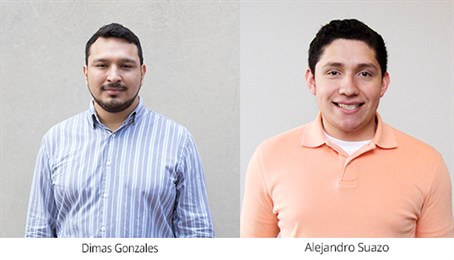 Unmanned vehicles could soon help provide first responders more context of unknown surroundings in crisis situations, thanks to Dimas Gonzales and Alejandro Suazo, two undergraduate students in the Department of Computer Science and Engineering at Texas A&M University.
Unmanned vehicles could soon help provide first responders more context of unknown surroundings in crisis situations, thanks to Dimas Gonzales and Alejandro Suazo, two undergraduate students in the Department of Computer Science and Engineering at Texas A&M University.
Dr. Jyh-Charn Lui, professor in computer science and engineering, tasked his students with designing and implementing a project that showcased the principles taught in his microcomputer systems course, such as signal processing and system design. Gonzales and Suazo took the project and ran with it.
In order to dispel the negativity often associated with unmanned vehicles, they decided to build a tool that would demonstrate the potential of their use in emergency situations. The duo decided to create a 3-D rendering system that utilized drone video capture in the hopes to ultimately provide emergency services more context of unknown surroundings.
They developed an automated system to generate 3-D point maps from footage manually captured on their phones. By using Structure from Motion (SfM), a process that approximates 3-D structures from 2-D images, they were able to create a point hub to generate an approximation of the target area.
The goal was to create a drone that would have the capability to record and transfer video to a central server. This was complex and took a lot of effort to complete. Once finished, the drone was able to autonomously capture video of any real object and run a mathematical analysis on the footage to generate a 3-D model.
“Oftentimes our classes limit our project's scope such that most students can reasonably complete said assignments,” Gonzales said. “Dr. Liu gave us the opportunity to really push ourselves, but he focused on making sure that we learned for ourselves how not to lose sight of our limitations.”
“This project gave me much satisfaction knowing that the skills I've learned the past few years are applicable in real applications which are both interesting and progressive when utilizing emerging technologies,” Suazo said.
Upon graduation, Suazo plans to work at USAA as a software engineer and continue to grow as a programmer while earning his Master’s degree in Business Administration. Gonzales will begin his career as a software developer for Capital One.
“I am delighted to see that Dimas and Alejandro used this opportunity to fully explore their potential in this class,” Liu said. “It is a very rewarding feeling to see so many students succeed in this class."